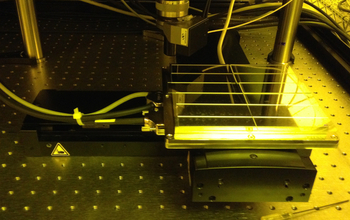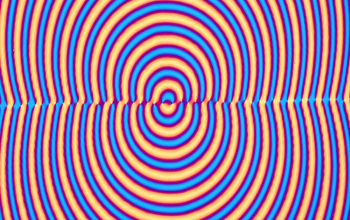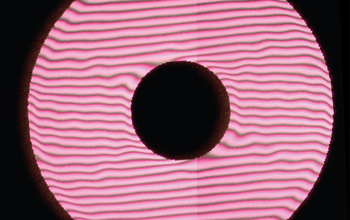All Images
Research News
4-D laser printing: holograms and beyond

This image shows a polarization grating patterned using the DWLS, where the colors arise from the periodic microstructure in the grating, dispersing the wavelengths present in the light source (not shown).
Credit: Michael Escuti, North Carolina State University
Download the high-resolution JPG version of the image. (2.9 MB)
Use your mouse to right-click (Mac users may need to Ctrl-click) the link above and choose the option that will save the file or target to your computer.

To understand how DWLS works, you have to understand that it doesn't have an inkjet--it prints light, and it prints in four dimensions.
The DWLS has a moveable X-Y translation platform on which substrates are placed, and the vertical final lens assembly through which the laser beam is focused to a tight spot.
Credit: Michael Escuti, North Carolina State University
Download the high-resolution JPG version of the image. (3.8 MB)
Use your mouse to right-click (Mac users may need to Ctrl-click) the link above and choose the option that will save the file or target to your computer.

The DWLS has found use in creating geometric phase holograms for use in mobile displays, holographic imaging and remote-sensing devices for everything from satellites to cameras. One high-profile application was the visually impressive Rainbow Station, an art installation conceived by Daan Roosegaarde and designed in partnership with Snik for the International Year of Light.
This image of a geometric phase hologram master was taken using a polarizing optical microscope. This pattern was replicated several times to create the Rainbow Station art installation.
Credit: Michael Escuti, North Carolina State University
Download the high-resolution JPG version of the image. (4.2 MB)
Use your mouse to right-click (Mac users may need to Ctrl-click) the link above and choose the option that will save the file or target to your computer.

For years, astronomers have devised telescopes that, in theory, can use light to help them unravel the mysteries of the universe. But these theoretical designs were often hampered by the limits of technology. Now Escuti was being asked to help turn theory into reality.
This composite image shows a geometric phase hologram called a vector apodizing phase plate (vAPP), where multiple images were taken using a polarizing optical microscope and stitched together. The vAPP was designed by astronomers at the University of Leiden, and together with astronomers at University of Arizona, is being used to study exoplanets.
Credit: Michael Escuti, North Carolina State University
Download the high-resolution JPG version of the image. (5.0 MB)
Use your mouse to right-click (Mac users may need to Ctrl-click) the link above and choose the option that will save the file or target to your computer.


